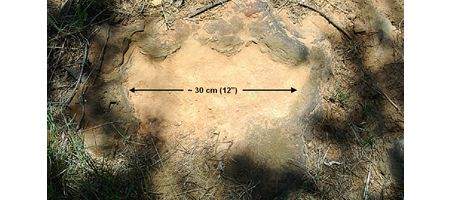As the Curiosity rover searches for signs of ancient life on Mars, it’s been discovered in NASA’s own back yard.

Dinosaur hunter Ray Stanford has discovered the footprint of a nodosaur – a herbivore dinosaur from the Cretaceous period – on the grounds of the Goddard Space Flight Center in Maryland.
“This was a large, armored dinosaur,” he says. “Think of it as a four-footed tank. It was quite heavy, there’s a quite a ridge or push-up here. … Subsequently the sand was bound together by iron-oxide or hematite, so it gave us a nice preservation, almost like concrete.”
The four-toed footprint, filled with yellow clay, shows the right rear foot of the low-slung, spiny leaf-eater – apparently in a hurry, as the heel did not fully settle in the cretaceous mud.
Material from the same Cretaceous-era sedimentary rock has been dated, with help from the US Geological Survey, to around 110 to 112 million years old, by analyzing pollen grains sealed in the stone.
Stanford also identified several smaller footprints, of three-toed, flesh-eating therapods, at the same site.
Goddard facilities manager Alan Binstock said the agency considers the footprint and its location ‘sensitive but unclassified’.
It’s on federal land, so improperly removing it could potentially violate three laws: the Antiquities Act, the Archaeological Resources Protection Act and the Paleontological Resources Preservation Act.
NASA officials will discuss how to document and preserve the find with paleontologists and the State of Maryland.
Stanford says the location of the find is ‘poetic’.
“Space scientists may walk along here, and they’re walking exactly where this big, bungling heavy armored dinosaur walked, maybe 110 to 112 million years ago,” he says.






